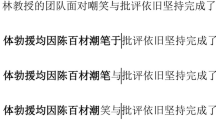Abstract
This is a pilot study report that explores one of the factors that influence one’s awareness of the extent of vision acuity other than biological reasons. Semantic factor is chosen to put to test to match the tests’ linguistic nature of words reading. Look-then-answer style of self-report method is adopted to better reflect this experiment’s goal of understanding how one “consciously knows” his or her quality of vision at that moment of words reading. By comparisons of fixating and gazing at a two-character segment of a reading line set in forms of Chinese and Korean characters of right-reading and wrong-reading versions, it can be checked to see how semantic factors influence one’s Peripheral Vision Acuity Fading Awareness (PVAFA). Results show the tendencies that partially support semantic-conditioned interpretations that: (1) the better a reading line’s semantic meaning understood, e.g., native Chinese readers gaze at Chinese characters, the more peripheral visions smeared than gazing at Korean characters; (2) the harder the lexical information can be identified, i.e., gazing at wrong-reading characters (in this case, upside-down typesetting), the lenient the PVAFA effect to occur. A follow-up discussion stresses how semantic factors mingle with vision acuity awareness in a lab set-up is worthy further hypothesized to probe its broader implications on visual form perception in both real world situations and human-computer interacted environments.
Chapter PDF
Similar content being viewed by others
References
Solso, R.L.: Cognition and Visual Arts. The MIT Press, MA (1994)
Bursill, A.E.: The restriction of peripheral vision during exposure to hot and humid conditions. Quarterly Journal of Experimental Psychology, 10–11 (1958)
Sanders, A.F.: Some aspects of the selective process in the functional visual field. Egonomics 13, 101–129 (1970)
Williams, L.J.: Forveal load affects the functional field of view. Human Performance 2(1), 1–28 (1989)
Craik & Lockart, F.M., Lockhart, R.S.: Levels of processing: A Framework for memory research. Journal of Verbal Learning and Verbal Behavior 11, 671–684 (1972)
Findlay, J.M., Walker, R.: A model of saccade generation based on parallel processing and competitive inhibition. Behavioral and Brain Sciences 22, 661–721 (1999)
McConkie, G.W., Rayner, K.: The span of the effective stimulus during a fixation in reading. Perception & Psychophysics 17, 578–586 (1975)
Engel, F.L.: Visual conspicuity and selective background interference in eccentric vision. Vision Research 14, 459–471 (1974)
Author information
Authors and Affiliations
Editor information
Editors and Affiliations
Rights and permissions
Copyright information
© 2011 Springer-Verlag Berlin Heidelberg
About this paper
Cite this paper
Wang, MC., You, M. (2011). Semantic-Conditioned Peripheral Vision Acuity Fading Awareness (PVAFA). In: Kurosu, M. (eds) Human Centered Design. HCD 2011. Lecture Notes in Computer Science, vol 6776. Springer, Berlin, Heidelberg. https://doi.org/10.1007/978-3-642-21753-1_39
Download citation
DOI: https://doi.org/10.1007/978-3-642-21753-1_39
Publisher Name: Springer, Berlin, Heidelberg
Print ISBN: 978-3-642-21752-4
Online ISBN: 978-3-642-21753-1
eBook Packages: Computer ScienceComputer Science (R0)




